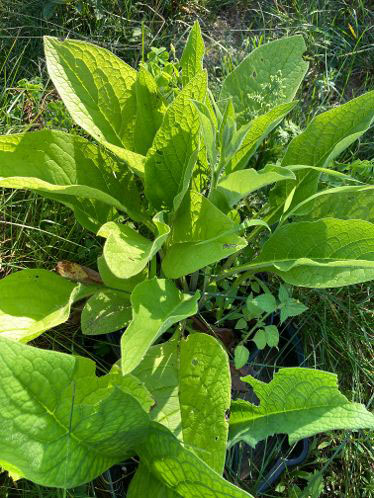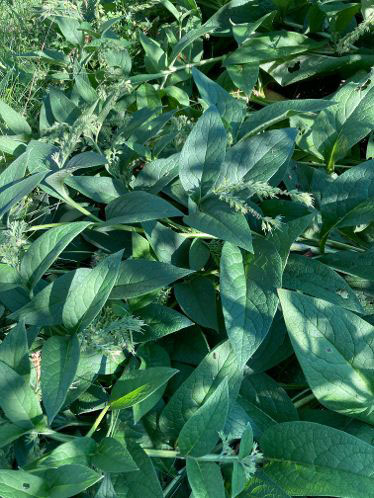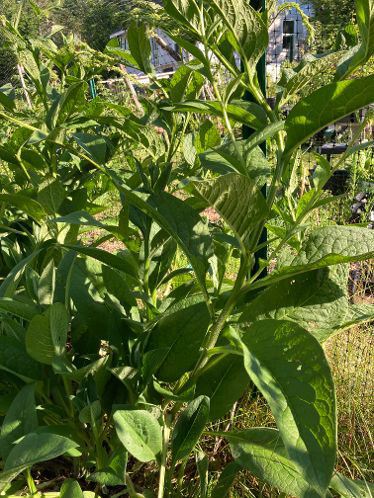 |
|
|
Comfrey (Symphytum officinale)
Comfrey (Bone Knit) Comfrey (Symphytum officinale) is an attractive ornamental plant used in gardening and medicine. It is called knitbone or boneset, referring to the bone-like growth of its roots. It also came as a reference to the belief that comfrey can mend broken bones. The plant has a long history in folk and ancient herbal treatments before comfrey is deemed unsafe for consumption. Today, comfrey is rarely used for food purposes for humans and animals. However, they are still propagated as garden ornamentals and as topical medicine. It is sold as ointments or topical salves and tinctures. It is also considered an excellent crop for mulching and organic fertilizing. Leaves. Comfrey leaves are green and rough because of the presence of hairs. The leaf type is simple and arranged in a rosette pattern. Each leaf is lanced or oval-shaped, and measures about 15 cm long and at least 7 to 15 cm wide. Flowers. The flowers of comfrey bloom in late spring to early winter. Depending on the variety, it may have purple, creamy yellow, or white blossoms. They are bell-shaped and arranged in drooping clusters. Each flower has five petals and sepals fused into a cup or tube. Fruits and Seeds. The true comfrey has a relatively low seed production. Its fruits are curved and drooped downwards. As it matures, it splits into four sections or nutlets that bear the tiny seeds. When dried, the comfrey roots are slimy and horn-like in appearance. Stem. The stems of comfrey are green, winged, and hairy. It often grows to about 30 cm high that elongates rapidly to about 120 cm. How To Grow Comfrey Today, you may buy comfrey seed varieties from online stores that are ready for planting but may not always be viable. Root cuttings are the least expensive and can also be availed online. Crown division is the fastest method to use. It will take only about ten days for the new plant to emerge. Before harvesting any parts of comfrey, make sure to wear durable gloves. The fine hairs in its stem and leaves can irritate the skin when it comes in contact with it. Comfrey is a fast-growing plant and will regrow its foliage sooner after cutting them back. If you want to use the leaves for tea or compost, harvest them before the bloom season. The best time for gathering the comfrey roots is in late fall. Dig up the roots, scrub them well, and chop them into pieces while they are still fresh before drying them. Dry the leaves or roots in the dehydrator or a warm oven. You may also air-dry these parts, but it may take time because they are fleshy. Comfrey is also prone to molds and wilting if they are not dried properly. Once the comfrey is thoroughly dried, store them in an airtight container in a dark place until ready for use. Discard the dried comfrey if you notice molds feasting on its surface. • Skin sores and irritations, wounds, eczema, sunburn Similar to Morphine: The Best Natural Painkiller That Grows in Your Backyard • Jar (size depends on how much oil you want to make) Steps: 1. Fill about 2/3 of the glass jar about with dried comfrey root. 2. Add the carrier oil and fill the jar all the way to the top. 3. Stir the mixture gently to release air pockets and cover the jar tightl. 4. Cover and label accordingly with a date. 5. For a solar infusion method, place the mixture in a sunny area for about 4 to 6 weeks. Shake the jar every few days. 6. After 4-6 weeks, strain the oil into another glass jar and label it. Apply the oil only to unbroken skin. Accordingly, topical application of comfrey should not go for more than 10 consecutive days. It will prevent bioaccumulation of its content that may be toxic to the body. Warnings And Cautions: Although comfrey was ingested traditionally, recent studies discovered its toxicity. Take it as a precaution and avoid taking comfrey orally. Apply comfrey products on unbroken skin not exceeding 10 consecutive days. Comfrey has mild interaction with liver drugs, which can increase the probability of liver damage when ingested. The topical application of comfrey is not recommended for pregnant and breastfeeding women. You should not also use comfrey if you have a history of liver disease, cancer, or alcohol abuse. Comfrey is, likewise, unsafe for children. |


